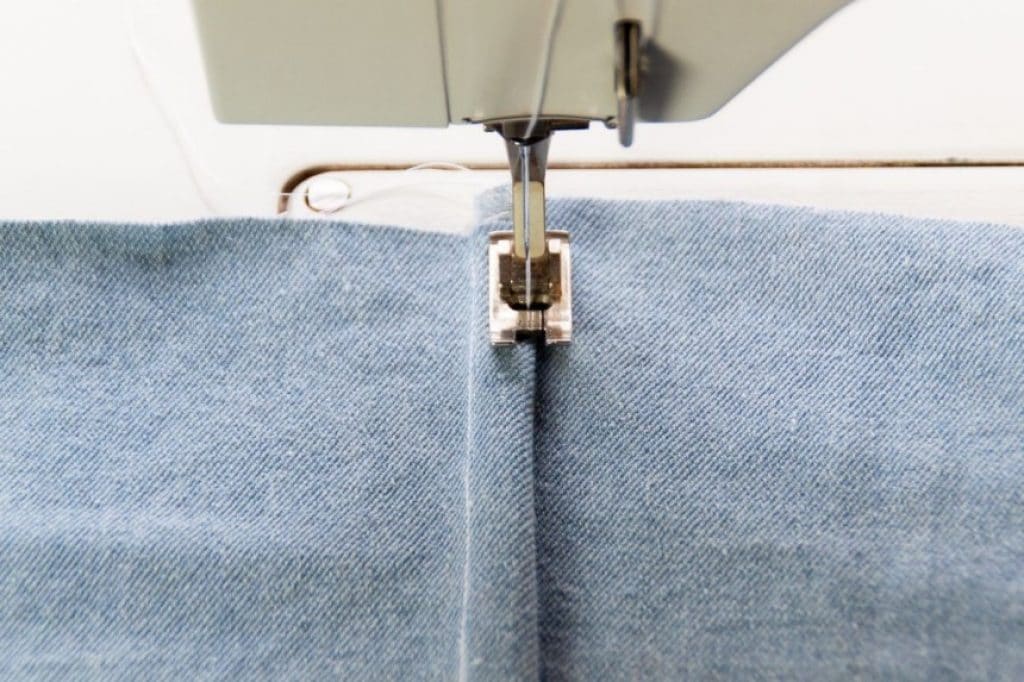

Flat felled seams are common in menswear like denim and jeans. You can also spot them in some children’s wear. Flat felled seams make two lines of stitches on fabrics; hence experts don’t recommend them for all fabrics.
There are different ways to make this kind of seams at home using basic tools like a standard sewing machine with a presser foot, scissors, pins, seam rippers and an iron. In this guide, we will look at the definition of a flat felled seam, the tools you need, how to make it with your hands or using a tool like a felling foot.
(Liking the technical how-tos? here’s one on how to lock stitches on a sewing machine! )
Flat felled seams are seams that you make by placing one edge of your fabric inside the folded edge of another fabric then stitching the fold.
You can make the fold intact using a topstitch or whipstitch. Experts say the fold is meant to protect the edges of the fabric from fraying. Like we mentioned earlier, flat-felled seams are common in tough fabrics like denim and children’s wear.
Unlike Hong Kong and French seams, these seams are flat. You can also make them on vulnerable fabrics like voile.
Major sewing processes require special equipment that makes the workload easy to handle. Creating flat-felled seams is no exception. You will need key tools like an appropriate needle and thread that matches your fabric.
Experts recommend using a denim-capable needle if you’re handling tough materials like jeans or denim (we quite like these) as well as needing strong and heavy threads. Target one that matches the color of the fabric.
You can invest in rayon or metallic for shine and a touch of bling respectively.
Standard presser feet seam perfectly. Most users advocate for Janome models. You can search for a sewing machine with a special sewing foot to make flat-felled seams. We quite like the Janome Heavy duty 3000 for this kind of work.
Get more tools like a sharp pair of scissors, pins and markers like pens and pencils.
Sewing a flat-felled seam by hand is easy. Most of the seams will be invisible if you did it properly. You should baste the seams before sewing. You can use safety pins, straight pins or quilting tools to baste your seams.
There are two popular approaches to sewing flat-felled seams by hands. You can start with the edges of the garments before stitching them together or join the seams first and finish with the edges of the fabric. Felling using hands can create seams that are flat and smooth.
First, attach the seam layer to the layer of your fabric while leaving half seam allowance. Fold the allowance of the longer seam over the shorter one. Hide the edges of the seams.
Use a whipstitch or running stitch to stitch the seam allowance that you folded. Experts recommend using 5 to 8 stitches per inch.
The tools you will need to sew a flat felled seam with the felling foot include a felling foot, pins, a marker and an iron. Start by pinning your fabrics. Measure, mark and draw a parallel line along the edge of the seam allowance using your measuring tool and marker.
Remember, different machines have varying feet, so ensure you measure and use a reasonable distance from the edge. Cut one side of the seam allowance along the line that you marked.
Fold the wide edge over the shorter one and press gently. Make a few stitches using the felling foot. Your hands should guide the edge of your fabric into the groove while stitching. Try to make your seams as straight as possible.
In this section, you will need pins, fabric shears, a standard presser foot, and an iron. First, pin your seams. Sew normally unless you want to use a specific pattern. Stick to a 5/8” allowance.
Use your shears to cut one of the sides of the allowance. Fold the wide seam allowance over the narrow one. Press it gently. Next, fold the whole seam allowance again and press. The edges will tuck in perfectly. Stitch the edges of the seam allowance.

You have all the steps you can use to make flat-felled seams today. You can do it by hand, use a felling foot or a standard presser foot. Experts advise everyone to stick to felling and standard presser foot if you can’t make straight hand stitches. Remember to invest in other vital tools like scissors and straight pins. Mastering the processes may take time, but it can save you lots of money in the long run.